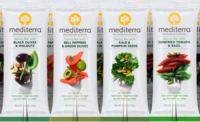Maple syrup, nuts, honey, salt and a whiff of campfire smoke; it sounds like the items for a dinner prepared by pioneers of yore. Rather, these are trending flavors and ingredients for today’s premium chocolate and confections. It’s, like, forward into the past.
So what’s making the evolution of confectionery product development bend back to its elemental roots?
“With Millennials driving over 93% penetration on the Internet, they are clearly influencing every level. They appear aligned and focused on a strong belief system that centers on labeling transparency and consumer trust for only clean-labeled ‘natural’ and ‘organic’ foods,” explains Blue Pacific Flavors’ CEO Donald Wilkes.
And emphasis on clean labels was very apparent at the PMCA annual production conference last month in Lancaster, Pa. Many of the exhibitors, including Blue Pacific, were exhibiting their new natural flavors and colors.
After all, their clients are demanding them.
Many top food brands have announced plans to reformulate their products to ditch artificial ingredients, reduce sugar levels and simplify the ingredients lists. This change is in response to consumer demand, 62 percent of whom prefer minimally processed foods and 53 percent seek foods made with recognizable ingredients, according to a recent Natural Marketing Institute survey.
Two recent announcements by major food manufacturers underscore how quickly this reformulation is taking place. By year’s end, both Nestlé (all chocolate candy products) and Kraft (its iconic Macaroni and Cheese) will remove all artificial colors and flavors.
These product reformulations were made possible by closing the gap in shade, stability and cost between natural and artificial colors, explains Gale Myers, technical services manager at Sensient Color. The color palette was significantly broadened when the FDA approved spirulina (blue) and iron oxide (red, yellow and black). “These newly permitted colors complete the palette of primary colors necessary to create better purples, pinks and blue shades.”
Sensient, and other color ingredient specialists, are also hard at work developing consumer preferred alternatives to caramel and food grade titanium dioxide, even though the risk to health for caramel and food grade titanium dioxide has not been established.
“This is interesting because in the past, many branded food companies took a more conservative wait-and-see approach when these issues came to the forefront. In today’s environment, where Vani Hari (AKA the Food Babe) can be considered by Time magazine as one of the most influential people on the Internet, caution is not as well rewarded as it was in the past,” Steve Morris, general manager for Sensient’s Market Trends, posted on the company website.
Meeting consumer expectations to reduce sugar levels in traditionally sugar-ladened confections will require ingenuity. For Blue Pacific’s Wilkes, that goal means totally “reimagining” the production process. Aiming to lower by 50 percent the sugar in milk chocolate, his company is experimenting with reducing cocoa’s bitterness, and hence the need for sugar, by adding MycoSmooth, a mushroom-based fermentation process developed by MycoTechnology.
Back to old-time sweeteners
Another trend is replacing artificial sweeteners with natural, alternative sweeteners. It’s an effort that can only accelerate, given that artificial sweeteners have recently been linked to childhood obesity and diet-related conditions like type 2 diabetes. At least that’s what the medical finding published recently in Appetite, an international research journal specializing in behavioral nutrition, suggests.
Sensing an opportunity for natural sweeteners, Firmenich has designated honey as its 2015 flavor of the year. Company literature extols honey’s attributes as imparting “a unique flavor impression that romances consumers of all ages.” Its flavor profiles, like wine, are influenced by terroir and season. And honey fits into the consumer zeitgeist of both artisanal and locally sourced foods and a better-for-you sweetener. Firmenich offers ten natural honey flavors, in liquid and powder form. Senior Food Technologist Eileen Bielenberg advises that these honey flavors can work “across the whole confectionery gamut.”
Blending honey with chile is a trending flavor variant. “The ‘bee sting sauce’ as it’s sometimes called, has become the hottest condiment since sriracha,” notes Sandy Cook, of Firmenich, in an interview in the February issue of the World of Food Ingredients magazine.
Another old-school natural sweetener receiving attention is maple. Frank Calabro, senior technologist with David Michael Flavors, reports the resurgence of old school maple sugar candies. That flavor seems to be driving the popularity of two-time SOFI award winning Tonewood’s maple products: the Maple Cube and Maple Wafer.
In a more complex sensory spin, Calabro anticipates more confections with maple-vanilla-bacon flavors. While bacon in confectionery applications is no stranger, the addition of maple evokes nostalgic Sunday morning pancake breakfasts. Chuao Chocolatier, always a trend setter, relaunched its Baconluxious Bar this January and it is one of the company’s best sellers, reports Brooke Feldman, communications director. According to the label, the bar contains “delicate maple sweetness, a sprinkle of bonfire smoked sea salt and crispy, uncured bacon in milk chocolate.”
A variation on the maple theme is maple and sea salt. Snack maker SuperSeedz has just launched Maple Sugar & Sea Salt, pumpkin seeds seasoned with maple sugar and unrefined sea salt. “It had to be Vermont maple sugar. We tested it in a small batch; everyone who tried it loved it. The rest is history,” reports President Joe Pelliccio. He anticipates that this flavor will become one of his best-selling snacks.
Savory sizzles
And speaking of salt, interest in specialty salts is booming. Confectioners and chocolatiers are venturing beyond generic sea salt to explore the rich flavor, texture and color diversity available with single origin and flavored salts.
At SaltWorks, a leading specialty salt provider, its confectioner and chocolatier customer base has quadrupled within the past 12 months, reports sales and media relations specialist Megan O’Keefe. She listed the company’s most popular categories for sweet applications as being flakey salts (like Artisan Cyprus Flake), French sea salts (such as Sel Gris, Tamise grain), Himalayan Pink salt, spicy sea salts (like Fusion Habanero Heat) and smoked sea salts (Robusto Extra Bold Smoked among others).
“The spicy/sweet combination of sea salt and habanero or chipotle is a wonderful balance of sweet, salty and spicy that is really popular right now, both in topping and inclusion applications; while the smoked sea salt can enhance the richer nuances in milk and dark chocolates and caramels,” reports O’Keefe.
What salt flavor might be tomorrow’s star? O’Keefe’s choice is Fusion Thai Ginger salt. To overcome any initial reluctance, “just a sprinkle over some vanilla ice cream will start imaginations and ideas rolling!”
Going one step beyond bacon, which might be prudent, Rose Potts foretells more jerky-flavored confections. Blommer Chocolate’s Corporate Manager of Sensory and Products Guidance ticked off two of jerky’s benefits: it’s softer in texture and Hershey’s recent purchase of Krave will drive up consumer interest. Adding to Potts, jerky has several elements in its favor: a source of protein, very paleo-friendly and a bona fide man food, a definite attraction given that these days more men are doing the shopping.
And rising consumer interest is driving this category’s premiumization trend. A case in point: Epic Provision’s Chicken Sesame BBQ Bar. This 2015 SOFI finalist is flavored with Asian-inspired sesame barbecue spice and, according to the manufacturer, is the world’s first chicken-based protein bar.
Another confectionery flavor trend is going up in smoke. Literally. Looking around the current batch of gourmet food shows, it seems that everything is getting smoked. To add a seductive beckoning allure to their products, the smokers call out the type of firewood: hickory, alder, or “bonfire” (whatever that means) as with the Chuaos’ Baconluxious Bar.
In my coverage of the 2014 summer Fancy Food Show, for example, I profiled Quin Candy’s Smoked Cola Gumdrops, containing alder wood smoked sugar. Owner/ confectioner Jami Curl says that this flavor, which is very popular with her male customers, is meant to evoke nostalgic memories of Coca Cola. Last year’s SOFI winners included Sticky Toffee Pudding Company’s Millionaire Shortbread with Smoked Hickory Sea Salt (SOFI gold) and Hot Cakes Molten Chocolate Cakery’s Smoked Chocolate Chips (SOFI silver). Potts has sniffed out other creative examples: smoked olive oil, brown sugar, cinnamon, and raspberries.
Then it’s not surprising to learn that the 2015 McCormick Flavor Forecast includes smoked spices among its eight flavor trends to watch. “Smoking spices and herbs deepens their flavor and aroma, adding richness to meals and drinks,” notes the report.
Health, texture in a nutshell
Sales of specialty nuts are also booming, driven by consumers’ desire for healthier snacking and plant-based sources of protein. In fact, proposed 2015 federal dietary guidelines recommends a diet containing more nuts and seeds as “more health promoting and is associated with less environmental impact” than the typical American diet that relies upon red and processed meat.
From the state that produces 80% of world almond production, the Almond Board of California has engaged in a marketing campaign that has cracked the market. Between 2009 and 2013, for example, global almond confectionery introductions grew by 23.3%, according to Innova Market Insights. By 2013, 31% of all chocolate consumed globally contained almonds, the Sterling Rice Group estimated. In short, “almonds and chocolate go hand and hand,” says Harbinder Maan, the board’s senior marketing manager.
Not to be outdone, the Turkish Hazelnut Promotion Group has also been actively promoting its nut. Stephanie Ries Kazan, U.S. marketing manager for the Turkish Hazelnut Promotion Group, ticked off that nut’s advantages: heart-healthy, pairs perfectly with chocolate and has a versatile flavor that works well in both sweet and savory applications.
“You can do so much with Turkish hazelnuts because they come in an array of forms from whole, to diced, to paste; and their flavor can be customized by using different roasting techniques,” she says. In fact, Mintel ranked hazelnut-flavored chocolate confections among its top 10 U.S. new product flavors from 2009 to 2014.
Among general trending flavors for confectionery products, Sensient’s Technical Services Manager Aminah Lewis has spotted “exotic fruits (notably super fruits), vegetable flavors and zippy citrus flavors.”
An example of “zippy” citrus flavors is Torie & Howard’s Sweet Meyer Lemon & Tart Fresh Raspberries Organic Hard Candy, a 2015 SOFI finalist.
For the snacks and soft chewy candy categories, there are several trending flavors of note. These include combinations of heat and sweet for adults and citrus flavors (including lemonade and other familiar sweet types) for kids, suggests Givaudan Flavors Senior Food Scientist Cynthia Angelo.
To make these two candy categories more nutritious, Blue Pacific Flavors has developed several natural plant-based flavor modifiers and whole food ingredient solutions. These products include SimplyGrains, Whole Oat Paste, Ricelife, Salba Chia seeds and low-water activity Soft-Fruits. Additionally, the company’s Farm Stand Farm to Flavor offers real whole food fruit flavors.
As we know, chefs and food TV are major influencers of confectionery flavor trends. So what’s trending on restaurant menus? To answer that, let’s examine the National Restaurant Association’s 2015 Culinary Forecast.
Among the top 10 food trends identified in this survey, three pertain to locally sourced ingredients. Obviously, one can’t locally produce cacao or sugar. But applying the term to what’s possible in confectionery, the trend could be more generally applied to local, made-by-your-neighborhood. The trend also underscores consumers’ interest in knowing the providence of the food they are eating. Some relevant examples: specifying on the label the chocolate’s country of origin or variety. Or, as John and Kira’s Chocolates have been doing for years, partnering with nearby urban community gardens in Philadelphia, Chicago, and Washington D.C. to source some of their ingredients (e.g., mint, rosemary and chile peppers) for their Urban Garden Chocolate Bar line.
Two additional trends in the Forecast’s top 10 involved environmental sustainability. Fortunately, our major chocolate companies are supporting such programs.
Among the survey’s top food picks with confectionery or dessert connotations are doughnuts (+12% increase in interest from prior year), ethnic condiments (+9%) – think Sriracha or oriental spice mixes – gelato (+7%), and house-made artisan ice cream (+6%). Among the bottom waning food trends were kale (-10%), gluten-free cuisine (-7%), Greek yogurt (-6%), bacon-flavored chocolate (-5%) and natural sweeteners (-5%).
So to summarize, trending confectionery flavor are naturally sweetened confections, sweet/salty, sweet/heat, smoky, nutty, locally sourced/made, and citrusy.
So, what flavors are yesterday’s news?
For Givaudan’s Angelo, yesterday’s news is super fruits. “They are still being used, but are not usually called out with this terminology anymore since they have moved to mainstream flavors.”
For Blue Pacific Flavors’ Wilkes, it’s artificial flavors and “natural” labeling and “healthy claims” (too much potential litigation, especially in regard to the KIND bar pending lawsuits).
For Sensient’s Myers, confections with extreme flavors, such as extreme sour and extreme heat, and product shapes and flavors that provide a “shock” factor are declining.
And that’s the wrap-up of this year’s premium confectionery flavor trends. These trends underscore an industry continuously driven by creativity and innovation to keep consumers excited. They also show an industry actively reformulating recipes to satisfy consumers’ demand for products with healthier ingredients.










